Cloud-Based Assessment of Flash Flood Susceptibility, Peak Runoff, and Peak Discharge on a National Scale with Google Earth Engine (GEE)
Abstract
1. Introduction
2. Materials and Methods
2.1. Overview of the Study Area
2.2. Methodology of FFPI Assessment in GEE
2.3. Methodology for Calculating the Peak Discharge in GEE
3. Results
3.1. Assessment of Flash Flood Potential Using FFPI
3.2. Assessment of the Peak Discharge
3.3. FFPI and Peak Discharge Validation
4. Discussion
5. Conclusions
Author Contributions
Funding
Institutional Review Board Statement
Informed Consent Statement
Data Availability Statement
Acknowledgments
Conflicts of Interest
References
- Blöschl, G.; Hall, J.; Viglione, A.; Perdigão, R.A.P.; Parajka, J.; Merz, B.; Lun, D.; Arheimer, B.; Aronica, G.T.; Bilibashi, A.; et al. Changing Climate Both Increases and Decreases European River Floods. Nature 2019, 573, 108–111. [Google Scholar] [CrossRef]
- Didovets, I.; Krysanova, V.; Bürger, G.; Snizhko, S.; Balabukh, V.; Bronstert, A. Climate Change Impact on Regional Floods in the Carpathian Region. J. Hydrol. Reg. Stud. 2019, 22, 100590. [Google Scholar] [CrossRef]
- Dobler, C.; Bürger, G.; Stötter, J. Assessment of Climate Change Impacts on Flood Hazard Potential in the Alpine Lech Water-shed. J. Hydrol. 2012, 460, 29–39. [Google Scholar] [CrossRef]
- Kane, S.; Shogren, J.F. Linking Adaptation and Mitigation in Climate Change Policy. Clim. Change 2000, 45, 75–102. [Google Scholar] [CrossRef]
- Moragoda, N.; Cohen, S. Climate-Induced Trends in Global Riverine Water Discharge and Suspended Sediment Dynamics in the 21st Century. Glob. Planet. Change 2020, 191, 103199. [Google Scholar] [CrossRef]
- Archer, D.R.; Leesch, F.; Harwood, K. Learning from the Extreme River Tyne Flood in January 2005. Water Environ. J. 2006, 21, 133–141. [Google Scholar] [CrossRef]
- Borga, M.; Boscolo, P.; Zanon, F.; Sangati, M. Hydrometeorological Analysis of the 29 August 2003 Flash Flood in the Eastern Italian Alps. J. Hydrometeorol. 2007, 8, 1049–1067. [Google Scholar] [CrossRef]
- Termeh, S.V.R.; Kornejady, A.; Pourghasemi, H.R.; Keesstra, S. Flood Susceptibility Mapping Using Novel Ensembles of Adaptive Neuro Fuzzy Inference System and Metaheuristic Algorithms. Sci. Total Environ. 2018, 615, 438–451. [Google Scholar] [CrossRef]
- Salhotra, Y.Z.; Walker, M. What We Know About the Floods in Central Texas. The New York Times, 20 July 2025. Available online: https://www.nytimes.com/article/texas-floods-kerr-county.html (accessed on 22 July 2025).
- European Centre for Medium-Range Weather Forecasts. Storm Boris and European Flooding September 2024; ECMWF: Reading, UK, 2024; Available online: https://www.ecmwf.int/en/about/media-centre/focus/2024/storm-boris-and-european-flooding-september-2024 (accessed on 23 July 2025).
- Barredo, J.I. Major Flood Disasters in Europe: 1950–2005. Nat. Hazards 2007, 42, 125–148. [Google Scholar] [CrossRef]
- Gaume, E.; Bain, V.; Bernardara, P.; Newinger, O.; Barbuc, M.; Bateman, A.; Blaškovičová, L.; Blöschl, G.; Borga, M.; Dumitrescu, A.; et al. A Collation of Data on European Flash Floods. J. Hydrol. 2009, 367, 70–78. [Google Scholar] [CrossRef]
- Costache, R. Flash-Flood Potential Assessment in the Upper and Middle Sector of Prahova River Catchment (Romania): A Comparative Approach between Four Hybrid Models. Sci. Total Environ. 2019, 659, 1115–1134. [Google Scholar] [CrossRef]
- Hong, H.; Tsangaratos, P.; Ilia, I.; Liu, J.; Zhu, A.-X.; Chen, W. Application of Fuzzy Weight of Evidence and Data Mining Tech-niques in Construction of Flood Susceptibility Map of Poyang County, China. Sci. Total Environ. 2018, 625, 575–588. [Google Scholar] [CrossRef] [PubMed]
- Jacinto, R.; Grosso, N.; Reis, E.; Dias, L.; Santos, F.D.; Garrett, P. Continental Portuguese Territory Flood Susceptibility Index: Contribution to a Susceptibility Index. Nat. Hazards Earth Syst. Sci. 2015, 15, 1907–1919. [Google Scholar] [CrossRef]
- Carpenter, T.; Sperfslage, J.; Georgakakos, K.; Sweeney, T.; Fread, D. National Threshold Runoff Estimation Utilizing GIS in Support of Operational Flash Flood Warning Systems. J. Hydrol. 1999, 224, 21–44. [Google Scholar] [CrossRef]
- Stefanidis, S.; Stathis, D. Assessment of Flood Hazard Based on Natural and Anthropogenic Factors Using Analytic Hierarchy Process (AHP). Nat. Hazards 2013, 68, 569–585. [Google Scholar] [CrossRef]
- Costache, R. Flood Susceptibility Assessment by Using Bivariate Statistics and Machine Learning Models—A Useful Tool for Flood Risk Management. Water Resour. Manag. 2019, 33, 3239–3256. [Google Scholar] [CrossRef]
- Youssef, A.M.; Pradhan, B.; Sefry, S.A. Flash Flood Susceptibility Assessment in Jeddah City (Kingdom of Saudi Arabia) Using Bivariate and Multivariate Statistical Models. Environ. Earth Sci. 2016, 75, 12. [Google Scholar] [CrossRef]
- Mudashiru, R.B.; Sabtu, N.; Abustan, I.; Balogun, W. Flood Hazard Mapping Methods: A Review. J. Hydrol. 2021, 603 Pt A, 126846. [Google Scholar] [CrossRef]
- Ajjur, S.B.; Mogheir, Y.K. Flood Hazard Mapping Using a Multi-Criteria Decision Analysis and GIS (Case Study Gaza Governorate, Palestine). Arab. J. Geosci. 2020, 13, 44. [Google Scholar] [CrossRef]
- Popa, M.C.; Peptenatu, D.; Draghici, C.; Diaconu, D.C. Flood Hazard Mapping Using the Flood and Flash-Flood Potential Index in the Buzău River Catchment, Romania. Water 2019, 11, 2116. [Google Scholar] [CrossRef]
- Marchi, L.; Borga, M.; Preciso, E.; Gaume, E. Characterisation of Selected Extreme Flash Floods in Europe and Implications for Flood Risk Management. J. Hydrol. 2010, 394, 118–133. [Google Scholar] [CrossRef]
- Costache, R.; Pham, Q.B.; Sharifi, E.; Linh, N.T.T.; Abba, S.; Vojtek, M.; Vojteková, J.; Nhi, P.T.T.; Khoi, D.N. Flash-Flood Susceptibility Assessment Using Multi-Criteria Decision Making and Machine Learning Supported by Remote Sensing and GIS Techniques. Remote Sens. 2019, 12, 106. [Google Scholar] [CrossRef]
- Aleksova, B.; Milevski, I.; Mijalov, R.; Marković, S.B.; Cvetković, V.M.; Lukić, T. Assessing Risk-Prone Areas in the Kratovska Reka Catchment (North Macedonia) by Integrating Advanced Geospatial Analytics and Flash Flood Potential Index. Open Geosci. 2024, 16, 20220684. [Google Scholar] [CrossRef]
- Milevski, I. Natural Hazards in the Republic of Macedonia with Special Emphasis on Flood and Earthquake in Skopje. Geogr. Rev. 2017, 50, 2016. Available online: https://igeografija.mk/reviews/wp-content/uploads/2022/01/GR50-05_NATURAL_HAZARDS_IN.pdf (accessed on 10 March 2025).
- Dragičević, S.; Filipović, D. Natural Conditions and Disasters in Planning to Protect Space, 2nd ed.; University of Belgrade—Faculty of Geography: Belgrade, Serbia, 2016. (In Serbian) [Google Scholar]
- Gavrilović, L.J. Floods in SR Serbia in the 20th Century—Causes and Consequences; Spec. Issue SGD 1981, No. 52; Serbian Geographical Society: Belgrade, Serbia, 1981. (In Serbian) [Google Scholar]
- Petrović, A. Flash Floods in Serbia; Spec. Editions SGD 2021, No. 73.; Serbian Geographical Society: Belgrade, Serbia, 2021; ISBN 978-86-82751-62-5. (In Serbian) [Google Scholar]
- Jovanović, D. Application of the Flash Flood Potential Index in Torrential Floods Risk Assessment (FFPI): A Case Study of Svilajnac Municipality. Proc. Fac. Geogr. Univ. Belgrade 2023, 71, 65–78. [Google Scholar] [CrossRef]
- Trobec, T. Spatio-Temporal Distribution of Flash Floods in Slovenia. Dela 2016, 46, 5–20. [Google Scholar] [CrossRef]
- Durlević, U.; Novković, I.; Lukić, T.; Valjarević, A.; Samardžić, I.; Krstić, F.; Batoćanin, N.; Mijatov, M.; Ćurić, V. Multi-Hazard Susceptibility Assessment: A Case Study—Municipality of Štrpce (Southern Serbia). Open Geosci. 2021, 13, 1414–1431. [Google Scholar] [CrossRef]
- Dragičević, S.; Kostadinov, S.; Novković, I.; Momirović, N.; Langović, M.; Stefanović, T.; Radović, M.; Tošić, R. Assessment of Soil Erosion and Torrential Flood Susceptibility: Case Study—Timok River Basin, Serbia. In The Lower Danube River, Hydro-Environmental Issues and Sustainability; Springer: Berlin, Germany, 2022; Chapter 12. [Google Scholar] [CrossRef]
- Lazarević, K.; Todosijević, M.; Vulević, T.; Polovina, S.; Momirović, N.; Caković, M. Determination of Flash Flood Hazard Areas in the Likodra Watershed. Water 2023, 15, 2698. [Google Scholar] [CrossRef]
- Krvavica, N.; Šiljeg, A.; Horvat, B.; Panđa, L. Pluvial Flash Flood Hazard and Risk Mapping in Croatia: Case Study in the Gospić Catchment. Sustainability 2023, 15, 1197. [Google Scholar] [CrossRef]
- Milevski, I.; Dragičević, S.; Radevski, I. GIS and Remote Sensing Based Natural Hazard Modelling of Kriva River Catchment, Republic of Macedonia. Z. Geomorphol. Suppl. 2017, 61, 213–228. [Google Scholar] [CrossRef]
- Aleksova, B.; Lukić, T.; Milevski, I.; Spalević, V.; Marković, S.B. Modelling Water Erosion and Mass Movements (Wet) by Using GIS-Based Multi-Hazard Susceptibility Assessment Approaches: A Case Study—Kratovska Reka Catchment (North Macedonia). Atmosphere 2023, 14, 1139. [Google Scholar] [CrossRef]
- Aleksova, B.; Lukić, T.; Milevski, I.; Puhar, D.; Marković, S.B. Preliminary Assessment of Geohazards’ Impacts on Geodiversity in the Kratovska Reka Catchment (North Macedonia). Geosciences 2024, 14, 62. [Google Scholar] [CrossRef]
- Aleksova, B.; Milevski, I.; Dragićević, S.; Lukić, T. GIS-Based Integrated Multi-Hazard Susceptibility Assessment in Makedonska Kamenica Municipality, North Macedonia. Atmosphere 2024, 15, 774. [Google Scholar] [CrossRef]
- Shawaqfah, M.; Almomani, F.; Khatatbeh, A.A. Mapping Flash Flood Potential and Risk Level Using GIS Techniques and the Flash Flood Potential Index (FFPI) in Amman Zarqa Basin of Jordan. Jordan J. Eng. Chem. Ind. 2020, 3, 81–90. [Google Scholar] [CrossRef]
- Sabljić, L.; Lukić, T.; Bajić, D.; Marković, S.B.; Spalevic, V.; Cvetković, V.M.; Delić, D.; Adžić, D.; Aleksova, B.; Milevski, I.; et al. Spatio-temporal analysis of flood events using GIS and remote sensing-based approach in the Ukrina River Basin, Bosnia and Herzegovina. Open Geosci. 2025, 17, 20250856. [Google Scholar] [CrossRef]
- Tamiminia, H.; Salehi, B.; Mahdianpari, M.; Quackenbush, L.; Adeli, S.; Brisco, B. Google Earth Engine for geo-big data applications: A meta-analysis and systematic review. ISPRS J. Photogramm. Remote Sens. 2020, 164, 152–170. [Google Scholar] [CrossRef]
- Khosravi, K.; Shahabi, H.; Pham, B.T.; Adamowski, J.; Shirzadi, A.; Pradhan, B.; Dou, J.; Ly, H.B.; Gróf, G.; Ho, H.L.; et al. A comparative assessment of flood susceptibility modeling using multi-criteria decision-making analysis and machine learning methods. J. Hydrol. 2019, 573, 311–323. [Google Scholar] [CrossRef]
- Costache, R.; Pham, Q.B.; Avand, M.; Linh, N.T.T.; Vojtek, M.; Vojteková, J.; Lee, S.; Khoi, D.N.; Nhi, P.T.T.; Dung, T.D. Novel hybrid models between bivariate statistics, artificial neural networks and boosting algorithms for flood susceptibility assessment. J. Environ. Manag. 2020, 265, 110485. [Google Scholar] [CrossRef] [PubMed]
- Luu, C.; Pham, B.T.; Phong, T.V.; Costache, R.; Nguyen, H.D.; Amiri, M.; Bui, Q.D.; Nguyen, L.T.; Le, H.V.; Prakash, I.; et al. GIS-based ensemble computational models for flood susceptibility prediction in the Quang Binh Province, Vietnam. J. Hydrol. 2021, 599, 126500. [Google Scholar] [CrossRef]
- Johary, R.; Révillion, C.; Catry, T.; Alexandre, C.; Mouquet, P.; Rakotoniaina, S.; Pennober, G.; Rakotondraompiana, S. Detection of Large-Scale Floods Using Google Earth Engine and Google Colab. Remote Sens. 2023, 15, 5368. [Google Scholar] [CrossRef]
- Halder, S.; Bose, S. Sustainable flood hazard mapping with GLOF: A Google Earth Engine approach. Nat. Hazards Res. 2024, 4, 573–578. [Google Scholar] [CrossRef]
- SELLAMI, E.M.; Rhinane, H. Google Earth Engine and Machine Learning for Flash Flood Exposure Mapping—Case Study: Tetouan, Morocco. Geosciences 2024, 14, 152. [Google Scholar] [CrossRef]
- Rahman, M.M.; Islam, M.A. Identifying the effect of monsoon floods on vegetation and land surface temperature by using Google Earth Engine. Environ. Monit. Assess 2023, 195, 834. [Google Scholar]
- Rahmati, O.; Pourghasemi, H.R.; Zeinivand, H. Flood susceptibility mapping using frequency ratio and weights-of-evidence models in the Golastan Province, Iran. Geocarto Int. 2016, 31, 42–70. [Google Scholar] [CrossRef]
- Kumar Samanta, R.; Bhunia, G.; Shit, P.; Pourghasemi, H.R. Flood susceptibility mapping using geospatial frequency ratio technique: A case study of Subarnarekha River Basin, India. Model. Earth Syst. Environ. 2018, 4, 395–408. [Google Scholar] [CrossRef]
- Gaume, E.; Borga, M. Post-flood field investigations in upland catchments after major flash floods: Proposal of a methodology and illustrations. J. Flood Risk Manag. 2008, 1, 175–189. [Google Scholar] [CrossRef]
- Giustarini, L.; Chini, M.; Hostache, R.; Pappenberger, F.; Matgen, P. Flood hazard mapping combining hydrodynamic modeling and multi-annual remote sensing data. Remote Sens. 2015, 7, 14200–14226. [Google Scholar] [CrossRef]
- Gigović, L.; Pamučar, D.; Bajić, Z.; Drobnjak, S. Application of GIS-interval rough AHP methodology for flood hazard mapping in urban areas. Water 2017, 9, 360. [Google Scholar] [CrossRef]
- Petroselli, A.; Vojtek, M.; Vojteková, J. Flood mapping in small ungauged basins: A comparison of different approaches for two case studies in Slovakia. Hydrol. Res. 2019, 50, 379–392. [Google Scholar] [CrossRef]
- Stefanidis, S.; Alexandridis, V.; Theodoridou, T. Flood exposure of residential areas and infrastructure in Greece. Hydrology 2022, 9, 145. [Google Scholar] [CrossRef]
- Osmanaj, L.; Milevski, I.; Aleksova, B. Integrated Rainfall Modeling and Hydrometeorological Alert System for Extreme Flooding in Kosovo. Preprints 2025, 2025, 071507. [Google Scholar] [CrossRef]
- Popescu, N.-C.; Bărbulescu, A. Flood hazard evaluation using a flood potential index. Water 2023, 15, 3533. [Google Scholar] [CrossRef]
- Kocsis, I.; Bilașco, Ș.; Irimuș, I.-A.; Dohotar, V.; Rusu, R.; Roșca, S. Flash flood vulnerability mapping based on FFPI using GIS spatial analysis: Case study: Valea Rea catchment area, Romania. Sensors 2022, 22, 3573. [Google Scholar] [CrossRef]
- Zaharia, L.; Costache, R.; Prăvălie, R.; Nițu, R.; Patriche, C.V.; Dobre, R. Mapping flood and flooding potential indices: A methodological approach to identifying areas susceptible to flood and flooding risk. Case study: The Prahova catchment (Romania). Front. Earth Sci. 2017, 11, 229–247. [Google Scholar] [CrossRef]
- Milevski, I.; Radevski, I.; Dimitrovska, O.; Gorin, S. Digital Model of the Mean Annual Temperature and Precipitation of the Republic of Macedonia. Geogr. Rev. 2015, 48, 33–38. Available online: https://igeografija.mk/reviews/wp-content/uploads/2022/01/GR48-Climate-models_Ivica_Milevski.pdf (accessed on 10 March 2025).
- Federal Geological Survey of SFRY. Interpreter of the Basic Geological Map of Socialist Federal Republic of Yugoslavia 100k (Sheet 25 for SR Macedonia); Prof. Fund Fed. Geol. Surv. SFRY: Belgrade, Yugoslavia, 1963–1985. (In Macedonian)
- Milevski, I.; Radevski, I.; Dimitrovska, O.; Drogreška, K.; Gorin, S. Study for the Spatial Plan of the Republic of North Macedonia 2021–2040: Natural Characteristics; Tech. No. A90123; Ministry of Environment and Spatial Planning: Skopje, North Macedonia, 2023. [Google Scholar]
- Djordjević, M.; Trendafilov, A.; Jelić, D.; Georgievski, S.; Popovski, A. Erosion Map of the Republic of Macedonia—Textual Part; Water Development Institute: Skopje, North Macedonia, 1993. (In Macedonian) [Google Scholar]
- Jovanovski, M.; Milevski, I.; Papić, J.B.; Peševski, I.; Markoski, B. Landslides in the Republic of Macedonia Triggered by Extreme Events in 2010. In Geomorphological Impacts of Extreme Weather: Case Studies from Central and Eastern Europe; Denes, L., Ed.; Springer: Berlin, Germany, 2013; pp. 265–280. [Google Scholar] [CrossRef]
- Petrović, A.; Kostadinov, S.; Dragićević, S. The Inventory and Characterization of Torrential Flood Phenomenon in Serbia. Pol. J. Environ. Stud. 2014, 23, 823–830. [Google Scholar]
- Petrović, A.; Dragićević, S.; Radić, B.; Milanović Pešić, A. Historical Torrential Flood Events in the Kolubara River Basin. Nat. Hazards 2015, 79, 537–547. [Google Scholar] [CrossRef]
- Smith, G. Flash Flood Potential: Determining the Hydrologic Response of FFMP Basins to Heavy Rain by Analyzing Their Physiographic Characteristics. 2003. Available online: https://www.cbrfc.noaa.gov/papers/ffp_wpap.pdf (accessed on 29 May 2024).
- Prăvălie, R.; Costache, R. The Analysis of the Susceptibility of the Flash-Floods’ Genesis in the Area of the Hydrographical Basin of Basca Chiojdului River. Forum Geogr. 2014, 13, 39–49. [Google Scholar] [CrossRef]
- Ristić, R.; Radić, B.; Vasiljević, N. Characteristics of Maximal Discharges on Torrential Watersheds in Serbia. Bull. Serbian Geogr. Soc. 2009, 89, 161–189. [Google Scholar] [CrossRef]
- Minea, G.; Iliescu, M.; Dedu, F. Temporal Rainfall Properties at Events Scale in the Curvature Subcarpathians (Romania). Forum Geogr. 2016, 15, 115–123. [Google Scholar] [CrossRef]
- Kostadinov, S.; Dragićević, S.; Stefanović, T.; Novković, I.; Petrović, A.M. Torrential Flood Prevention in the Kolubara River Basin. J. Mt. Sci. 2017, 14, 2230–2245. [Google Scholar] [CrossRef]
- Zogg, J.; Deitsch, K. The Flash Flood Potential Index at WFO Des Moines, Iowa. 2013. Available online: https://www.weather.gov/media/lmrfc/tech/2016_Vulnerability_Component_FFPI.pdf (accessed on 10 March 2025).
- Brewster, J. Development of the Flash Flood Potential Index. 2009. Available online: http://bgmresearch.eas.cornell.edu/research/ERFFW/abstracts/brewster_development_of_the_flash_flood_potent.pdf (accessed on 5 March 2025).
- Kruzdlo, R. Flash Flood Potential Index for the Mount Holly Hydrologic Service Area. 2010. Available online: https://www.nj.gov/drbc/library/documents/Flood_Website/flood-warning/user-forums/Krudzlo_NWS.pdf (accessed on 10 March 2025).
- Ceru, J. Flash Flood Potential Index (FFPI) for Pennsylvania. In Proceedings of the ESRI Federal GIS Conference, Washington, DC, USA, 22–24 February 2012; Available online: https://proceedings.esri.com/library/userconf/feduc12/papers/user/joeceru.pdf (accessed on 10 March 2025).
- Arachchige, R.; Perera, D.J. Mapping Flash Flood Potential Using GIS and the Flash Flood Potential Index (FFPI) in the Turtle River and Forest River Watersheds in North Dakota. Master’s Thesis, University of North Dakota, Grand Forks, ND, USA, 2015. [Google Scholar]
- European Space Agency. Copernicus GLO-30 Digital Elevation Model; OpenTopography: San Diego, CA, USA, 2020. [Google Scholar]
- European Space Agency. ESA WorldCover 10 m 2021 v100; ESA WorldCover Consortium: Mol, Belgium, 2021. [Google Scholar]
- Panagos, P.; Borrelli, P.; Meusburger, K.; van der Zanden, E.H.; Poesen, J.; Alewell, C. Modelling the Effect of Support Practices (P-Factor) on the Reduction of Soil Erosion by Water at European Scale. Environ. Sci. Policy 2015, 51, 23–34. [Google Scholar] [CrossRef]
- Zanaga, D.; Van De Kerchove, R.; De Keersmaecker, W.; Souverijns, N.; Brockmann, C.; Quast, R.; Wevers, J.; Grosu, A.; Paccini, A.; Vergnaud, S.; et al. ESA WorldCover 10 m 2020 v100; ESA WorldCover Consortium: Mol, Belgium, 2021. [Google Scholar] [CrossRef]
- Poggio, L.; de Sousa, L.M.; Batjes, N.H.; Heuvelink, G.B.M.; Kempen, B.; Ribeiro, E.; Rossiter, D. SoilGrids 2.0: Producing Soil Information for the Globe with Quantified Spatial Uncertainty. SOIL 2021, 7, 217–240. [Google Scholar] [CrossRef]
- Wischmeier, W.H.; Smith, D.D. Predicting Rainfall Erosion Losses, A Guide to Conservation Planning; USDA Agricultural Handbook No. 537; U.S. Department of Agriculture: Beltsville, ML, USA, 1978. Available online: https://www.ars.usda.gov/ARSUserFiles/60600505/RUSLE/AH_537%20Predicting%20Rainfall%20Soil%20Losses.pdf (accessed on 15 March 2025).
- United States Geological Survey. Sentinel-2 Data Products. 2024. Available online: https://www.usgs.gov/centers/eros/science/usgs-eros-archive-sentinel-2 (accessed on 10 April 2025).
- Milevski, I.; Aleksova, B.; Lukić, T.; Dragićević, S.; Valjarević, A. Multi-Hazard Modeling of Erosion and Landslide Susceptibility at the National Scale in the Example of North Macedonia. Open Geosci. 2024, 16, 20220718. [Google Scholar] [CrossRef]
- Gorelick, N.; Hancher, M.; Dixon, M.; Ilyushchenko, S.; Thau, D.; Moore, R. Google Earth Engine: Planetary-Scale Geospatial Analysis for Everyone. Remote Sens. Environ. 2017, 202, 18–27. [Google Scholar] [CrossRef]
- Zhao, J.; Du, D.; Chen, L.; Liang, X.; Chen, H.; Jin, Y. HA-Net for Bare Soil Extraction Using Optical Remote Sensing Images. Remote Sens. 2024, 16, 3088. [Google Scholar] [CrossRef]
- Renard, K.G.; Foster, G.R.; Weesies, G.A.; McCool, D.K.; Yoder, D.C. Predicting Soil Erosion by Water: A Guide to Conservation Planning with the Revised Universal Soil Loss Equation (RUSLE); Agriculture Handbook No. 703; U.S. Department of Agriculture: Washington, DC, USA, 1997. Available online: https://www.tucson.ars.ag.gov/unit/publications/PDFfiles/717.pdf (accessed on 20 May 2025).
- Smith, B.K.; Smith, J.A.; Baeck, M.L. Flash Flood–Producing Storm Properties in a Small Urban Watershed. J. Hydrometeorol. 2016, 17, 2631–2647. [Google Scholar] [CrossRef]
- Funk, C.; Peterson, P.; Landsfeld, M.; Pedreros, D.; Verdin, J.; Shukla, S.; Husak, G.; Rowland, J.; Harrison, L.; Hoell, A.; et al. The Climate Hazards Infrared Precipitation with Stations—A New Environmental Record for Monitoring Extremes. Sci. Data 2015, 2, 150066. [Google Scholar] [CrossRef]
- Hersbach, H.; Bell, B.; Berrisford, P.; Hirahara, S.; Horányi, A.; Muñoz-Sabater, J.; Nicolas, J.; Peubey, C.; Radu, R.; Schepers, D.; et al. The ERA5 global reanalysis. Q. J. R. Meteorol. Soc. 2020, 146, 1999–2049. [Google Scholar] [CrossRef]
- Huffman, G.J.; Bolvin, D.T.; Braithwaite, D.; Hsu, K.; Joyce, R.; Kidd, C.; Nelkin, E.J.; Sorooshian, S.; Tan, J.; Xie, P. NASA Global Precipitation Measurement (GPM) Integrated Multi-Satellite Retrievals for GPM (IMERG) Algorithm Theoretical Basis Document (ATBD), Version 06; National Aeronautics and Space Administration (NASA): Greenbelt, MD, USA, 2020. Available online: https://gpm.nasa.gov/sites/default/files/2020-05/IMERG_ATBD_V06.3.pdf (accessed on 27 May 2025).
- Merz, R.; Blöschl, G.; Parajka, J. Spatio-Temporal Variability of Event Runoff Coefficients. J. Hydrol. 2006, 331, 591–604. [Google Scholar] [CrossRef]
- Gjeshovska, V.; Taseski, G.; Ilioski, B. Heavy Rainfall in the R.N. Macedonia. Sci. J. Civ. Eng. 2021, 10, 19–30. [Google Scholar] [CrossRef]
- Dumova-Jovanovska, E.; Cvetovska, M.; Čurilov, S.; Milkova, K.; Bogoevska, S.; Jovanoska Mitrevska, M.; Donevska, K.; Gješovska, V.; Ilioski, B.; Jovanovski, M.; et al. Study for the Spatial Plan of the Republic of North Macedonia: Natural and Technical-Technological Disasters; Tech. No. A91923; Ministry of Environment and Spatial Planning: Skopje, North Macedonia, 2023. [Google Scholar]
- Vasileski, D.; Radevski, I. Analysis of High Waters on the Kriva Reka River, Macedonia. Acta Geogr. Slov. 2014, 54, 363–377. [Google Scholar] [CrossRef][Green Version]
- Ministry of Environment and Spatial Planning. Fourth National Climate Change Action Plan; Ministry of Environment and Spatial Planning, GEF, UNDP: Skopje, North Macedonia, 2023. (In Macedonian) [Google Scholar]
- Milevski, I.; Dragićević, S.; Georgievska, A. GIS and RS-Based Modelling of Potential Natural Hazard Areas in Pehchevo Municipality, Republic of Macedonia. J. Geogr. Inst. Jovan Cvijić S0ASA 2012, 63, 95–107. [Google Scholar] [CrossRef]
- Popovska, C.; Gjeshovska, V.; Ivanoski, D. Floods in Upper Vardar River Basin, May 2006. In Proceedings of the International Conference on Water Observation and Information System for Decision Support BALWOIS, Ohrid, North Macedonia, 23–26 May 2006. [Google Scholar] [CrossRef]
- Popovska, C.; Jovanovski, M.; Sekovski, D. Build Back Better Approach to Recovery of Flood-Damaged Transport and Water Infrastructure. In Proceedings of the Water Management and Hydraulic Engineering, Skopje, North Macedonia, 5–7 September 2019. [Google Scholar]
- Hydrometeorological Service of the Republic of North Macedonia (UHMR). Annual Report 2023. Available online: https://uhmr.gov.mk/ (accessed on 23 July 2025).
- Popovska, C.; Gjeshovska, V. Water Balance Model for Susceptibility Assessment of Water Resources in Strumica River Basin. Irrig. Drain. Syst. Eng. 2014, 3, 1000127. [Google Scholar] [CrossRef]
- Djurdjevic, V. Report on Climate Change Projections and Changes in Climate Extremes for the Republic of North Macedonia. In Macedonia’s Fourth National Communication and Third Biennial Update Report on Climate Change under the UNFCCC; Ref. No. IC 44/2019; GEF and UNDP: Skopje, North Macedonia, 2020. [Google Scholar]
- Bertola, M.; Castellarin, A.; Viglione, A.; Valtancoli, E.; Blöschl, G. Frequency and Spatial Variability of European Record Floods. Water Resour. Res. 2024, 60, e2023WR036767. [Google Scholar] [CrossRef]
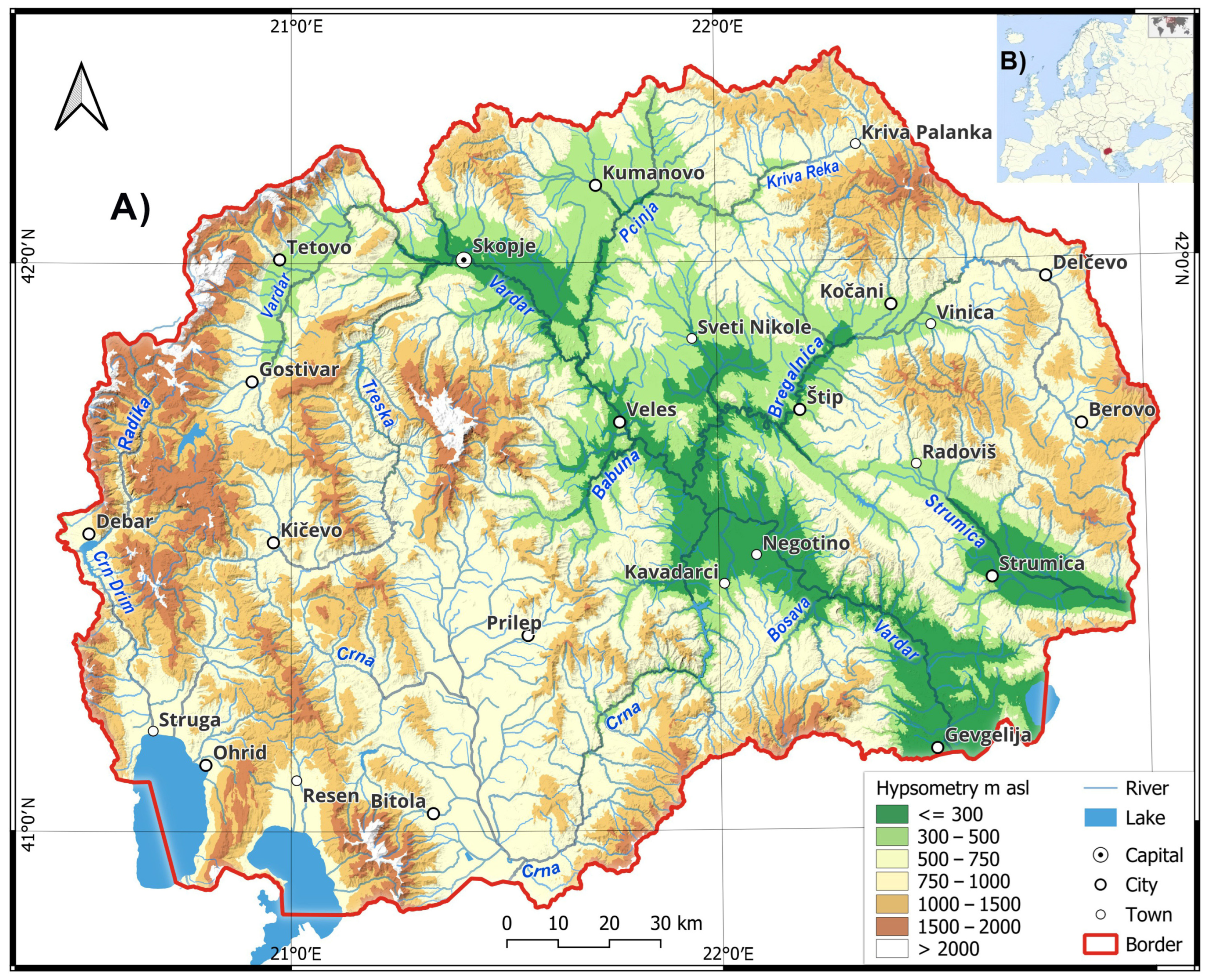
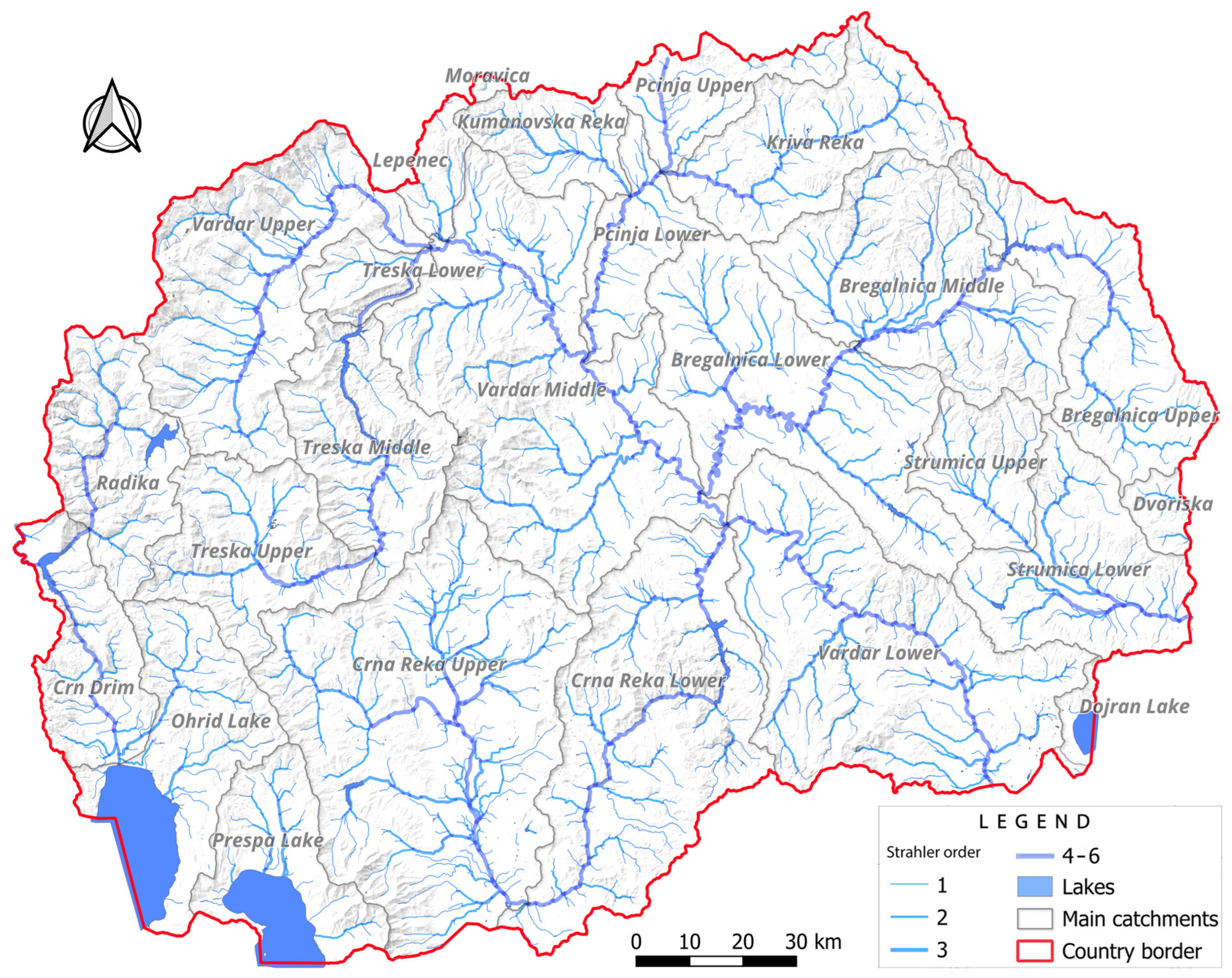

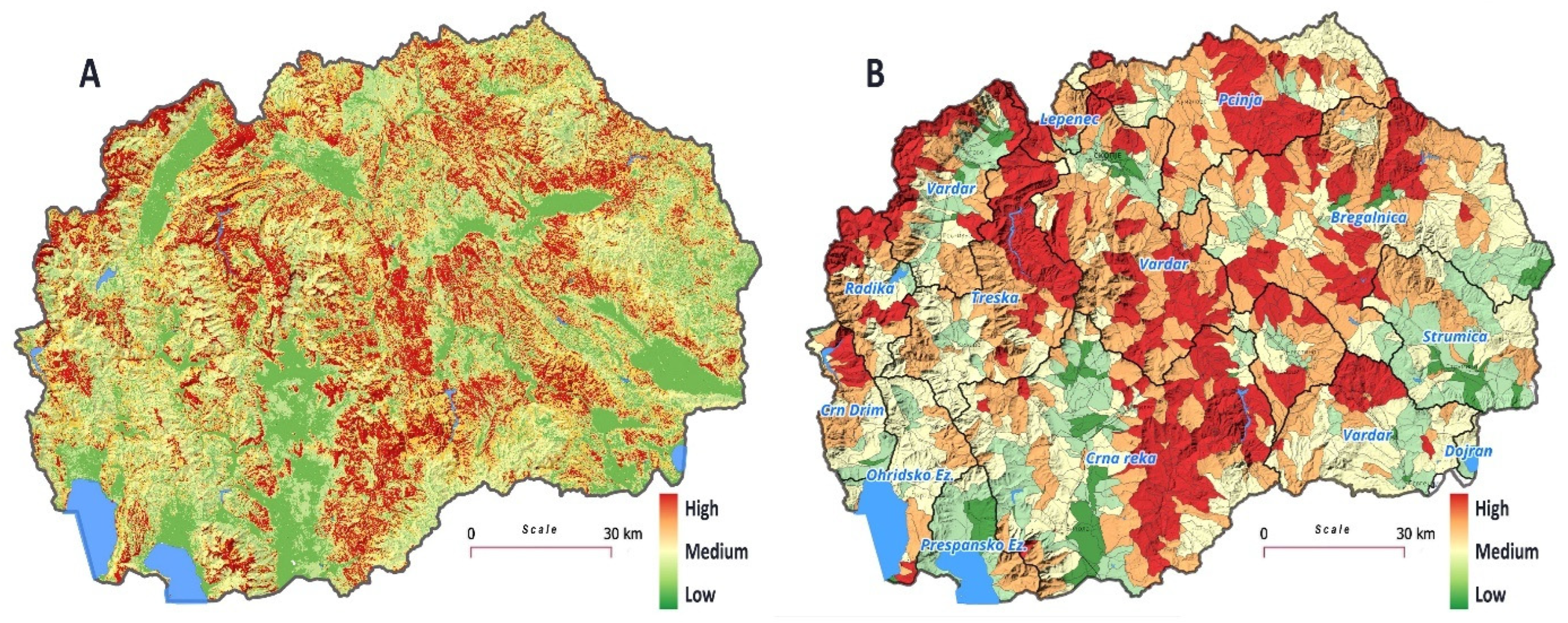

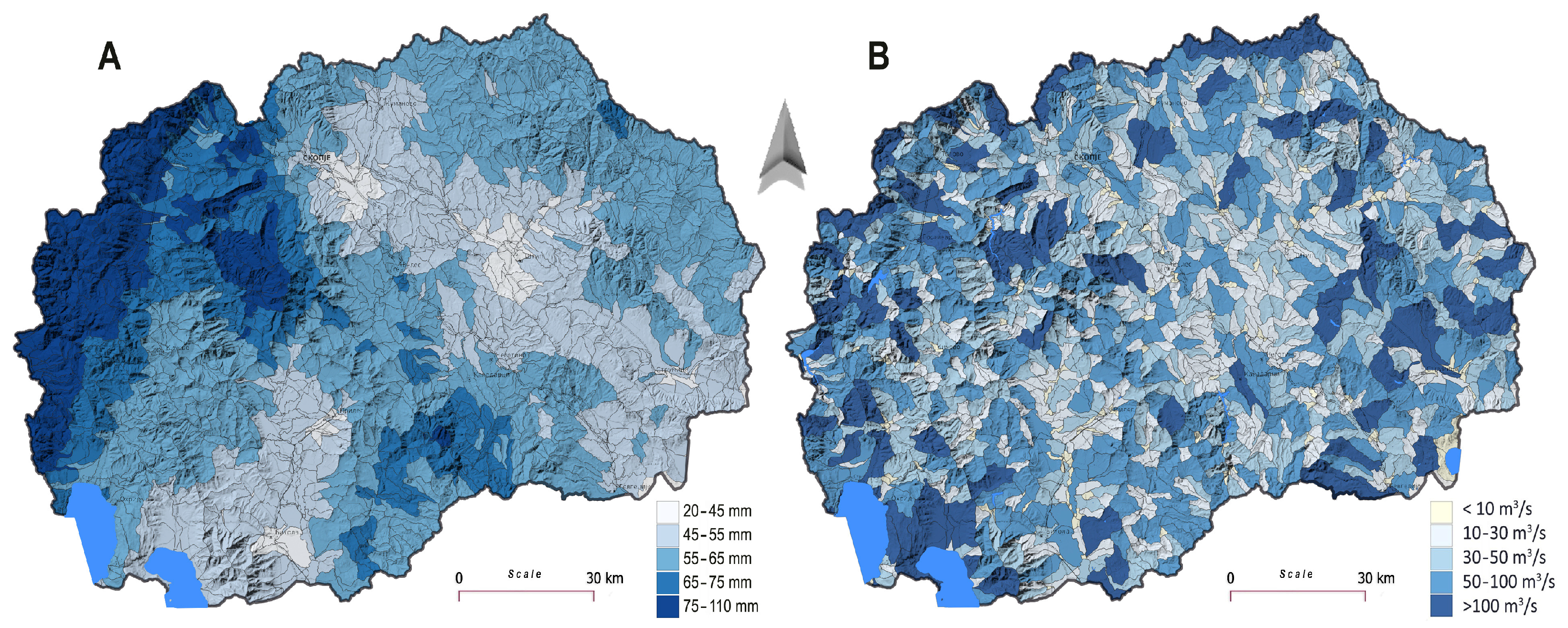
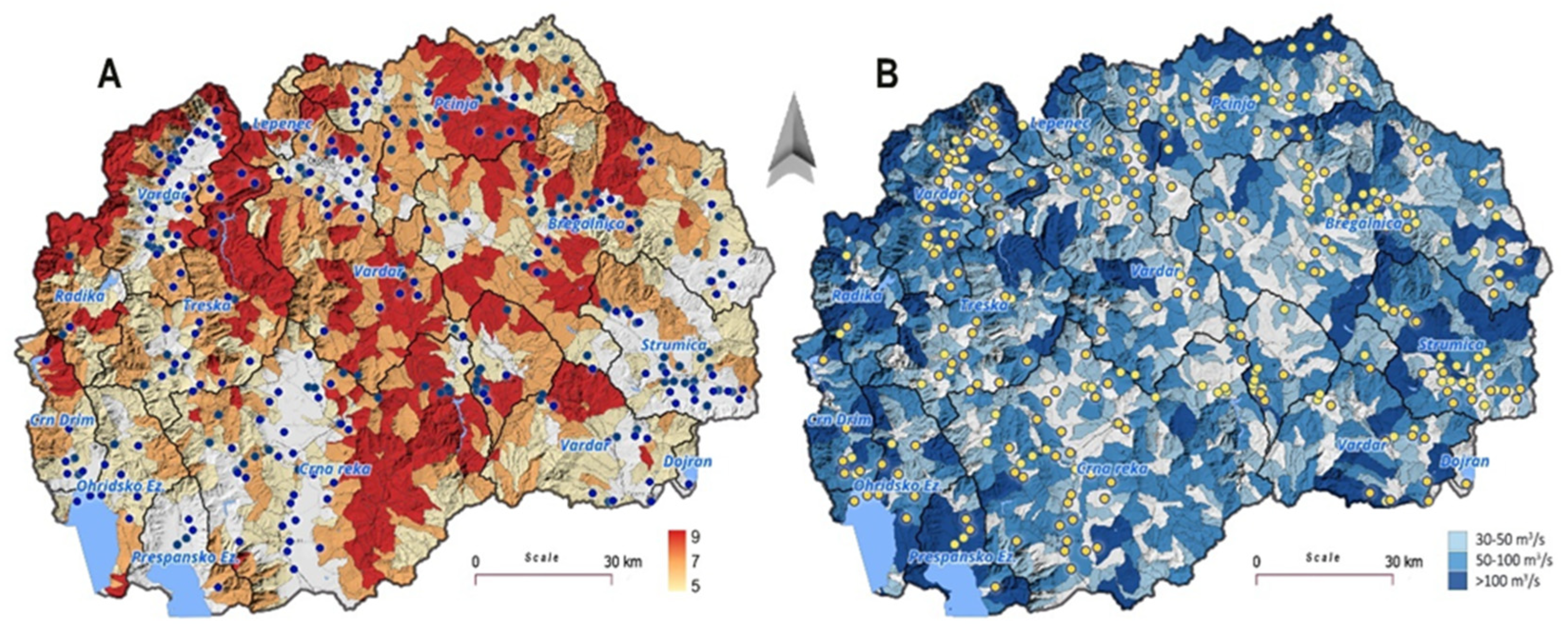
| Coeff. M | Slope % | Area % |
|---|---|---|
| 1 | 0–3 | 12.2 |
| 2 | 3–6 | 6.0 |
| 3 | 6–9 | 5.4 |
| 4 | 9–12 | 5.2 |
| 5 | 12–15 | 5.1 |
| 6 | 15–18 | 5.1 |
| 7 | 18–21 | 5.1 |
| 8 | 21–24 | 5.2 |
| 9 | 24–30 | 5.1 |
| 10 | >30% | 45.4 |
| Land Use Classes | Value | Area % |
|---|---|---|
| Tree cover | 1 | 48.7 |
| Herbaceous wetland | 2 | 0.1 |
| Shrubland | 3 | 1.3 |
| Grassland | 5 | 32.5 |
| Cropland | 6 | 13.5 |
| Built-up | 8 | 1.8 |
| Bare-sparse vegetation | 10 | 0.4 |
| Permanent water bodies | - | 1.7 |
| Total | 100.0 |
| Flash Flood Susceptibility | Value | Area | |
|---|---|---|---|
| km2 | % | ||
| Very low | 2.8–4.5 | 2695.0 | 10.7 |
| Low | 4.5–5.0 | 4438.5 | 17.6 |
| Moderate | 5.0–5.5 | 6635.1 | 26.2 |
| High | 5.5–6.0 | 5422.6 | 21.4 |
| Very high | 6.0–9.2 | 6096.5 | 24.1 |
| All FFPI | 2.8–9.2 | 25,287.7 | 100.0 |
| Lakes | - | 425.3 | 1.7 |
| Total country area | 25,713 | 100.0 | |
| Area % | Area km2 | No. | Values | Class |
|---|---|---|---|---|
| 3.3 | 834.5 | 134 | 2.9–4.7 | Very low |
| 14.3 | 3616.1 | 196 | 4.7–5.1 | Low |
| 36.9 | 9331.2 | 318 | 5.1–5.4 | Moderate |
| 25.1 | 6347.2 | 446 | 5.4–5.8 | High |
| 20.3 | 5133.4 | 302 | 5.8–7.6 | Very high |
| 100 | 25,287.7 | 1396 | 2.9–7.6 | Total |
| 1.7 | 425.3 | - | Water b. | |
| 100 | 25,713 | Country area |
| Average Area (km2) | Total Area (km2) | No. of Catchments | Discharge (m3/s−1) |
|---|---|---|---|
| 1.6 | 403.8 | 297 | 0–10 |
| 17.8 | 4504 | 405 | 10–30 |
| 25.4 | 6412.6 | 337 | 30–50 |
| 34.9 | 8819.3 | 267 | 50–100 |
| 20.4 | 5148.1 | 90 | >100 |
| 100 | 25,287.7 | 1396 | All |
| 1.7 | 425.3 | - | Lakes |
| Catchment | Station | Observ. m3/s | Model. m3/s | Area km2 | Diff. |
|---|---|---|---|---|---|
| Bregalnica (up.) | Berovo | 57.6 | 67.3 | 102.0 | 1.17 |
| Bregalnica (up.) | Budinarci | 233.0 | 208.2 | 315.6 | 0.89 |
| Bregalnica (up.) | Očipale | 396.0 | 382.0 | 75.0 | 0.96 |
| Kamenička R. | M.Kamenica | 86.1 | 86.2 | 118.3 | 1.00 |
| Orizarska R. | Orizari | 97.8 | 92.4 | 128.2 | 0.94 |
| Kočanska R. | Gradče | 62.2 | 71.2 | 105.8 | 1.14 |
| Zletovska R. | Zletovo | 148.2 | 152.1 | 218.7 | 1.03 |
| Lipkovska R. | Kumanovo | 110.0 | 126.8 | 296.2 | 1.15 |
| Kriva Reka | Trnovac | 313.0 | 346.3 | 537.4 | 1.11 |
| Radika R. | Žirovnica | 262.0 | 427.3 | 375.2 | 1.63 |
| Dvoriška R. | Dvorište | 27.7 | 35.1 | 58.2 | 1.27 |
| Radoviška R. | Radoviš | 95.0 | 110.2 | 69.6 | 1.16 |
Disclaimer/Publisher’s Note: The statements, opinions and data contained in all publications are solely those of the individual author(s) and contributor(s) and not of MDPI and/or the editor(s). MDPI and/or the editor(s) disclaim responsibility for any injury to people or property resulting from any ideas, methods, instructions or products referred to in the content. |
© 2025 by the authors. Licensee MDPI, Basel, Switzerland. This article is an open access article distributed under the terms and conditions of the Creative Commons Attribution (CC BY) license (https://creativecommons.org/licenses/by/4.0/).
Share and Cite
Milevski, I.; Aleksova, B.; Valjarević, A.; Gorsevski, P. Cloud-Based Assessment of Flash Flood Susceptibility, Peak Runoff, and Peak Discharge on a National Scale with Google Earth Engine (GEE). Atmosphere 2025, 16, 945. https://doi.org/10.3390/atmos16080945
Milevski I, Aleksova B, Valjarević A, Gorsevski P. Cloud-Based Assessment of Flash Flood Susceptibility, Peak Runoff, and Peak Discharge on a National Scale with Google Earth Engine (GEE). Atmosphere. 2025; 16(8):945. https://doi.org/10.3390/atmos16080945
Chicago/Turabian StyleMilevski, Ivica, Bojana Aleksova, Aleksandar Valjarević, and Pece Gorsevski. 2025. "Cloud-Based Assessment of Flash Flood Susceptibility, Peak Runoff, and Peak Discharge on a National Scale with Google Earth Engine (GEE)" Atmosphere 16, no. 8: 945. https://doi.org/10.3390/atmos16080945
APA StyleMilevski, I., Aleksova, B., Valjarević, A., & Gorsevski, P. (2025). Cloud-Based Assessment of Flash Flood Susceptibility, Peak Runoff, and Peak Discharge on a National Scale with Google Earth Engine (GEE). Atmosphere, 16(8), 945. https://doi.org/10.3390/atmos16080945








